1971 (11 Issued and 13 Unissued)
Two covers were returned due to the Bangladesh War of Independence. The top cover was sent from Switzerland to Rajshahi, and the second cover was sent from Karachi, Pakistan to Dacca (East Pakistan) on 16 December 1971.

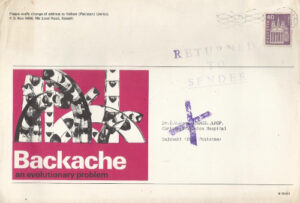
29 July – First Stamps of Bangladesh
The cover below has a Kasipur postmark, and the cover beneath it bears a Mujibnagar postmark. The Mujibnagar cover is known with cancellation strikes in both black and purple ink
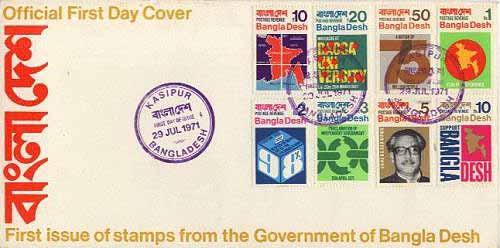
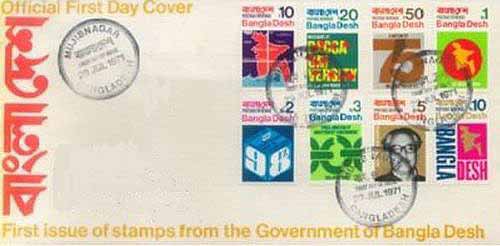
71-1 10p Map
71-2 20p Massacre at Dacca University
71-3 50p Nation of 75 Million People
71-4 R.1 Flag with silhouette of Bangladesh in the centre
71-5 Rs.2 Ballot Box
71-6 Rs.3 Broken Chain – Proclamation of Independent Government
71-7 Rs.5 Sheikh Mujibur Rahman
71-8 Rs.10 Support Bangladesh
Total Stamps: 8
CCMs: Yes
Plate Numbers:
• 1A known on 10p, 20p, 50p, 1R, 3R, and 10R
• 1B known on 50p, 2R, 5R, and 10R
(See link to Additional Information below)
Perforation: 14½ × 14½
Sheet Size: 50
Quantity Printed: Unknown
Designer: Biman Mallik
Printer: Format International Security Printers Ltd., UK
FDC: Yes. Generic postmark reads FIRST POSTAGE STAMPS OF BANGLADESH / CENTRAL / POST OFFICE / 29 JULY 71 with Bangladesh in Bangla.
Two different cachets are known:
Green cachet with all inscriptions in green and the country name written as “Bangladesh” in English.
Red and yellowish-brown cachet with the country name written as “BanglaDesh” in English and with larger English lettering than on the green cachet.
Postmarks: Kasipur (purple), Mujibnagar, Philatelic Bureau – Dacca
Insert: None
Additional Notes
It was once reported that imperforate stamps existed from the archives of Format International Security Printers Ltd., allegedly sold when the press closed. However, no confirmed examples have been recorded. The imperforate variety has therefore been removed from this catalogue until their existence can be verified.
Further assistance is needed to accurately record all plate numbers for this issue. Only those personally seen by the author are listed at this time.
PLATE NUMBERS AND CCMS
The problem is complicated by the placement of the vertical text printed along either the left or right margin of the sheets. This text consists of three continuous lines reading “Format International Security Printers, Ltd.” and appears down most of the left or right margin. In some cases it appears on the same side as the plate numbers; in others it appears on the side with the CCMs. It may also appear closer to the top or closer to the bottom of the sheet.
One possible explanation is that larger master sheets were printed containing four complete panes of the stamps, which were then cut into individual sheets. If so, the three lines of marginal text may originally have been near the centre of the master sheet, and once cut, would appear either at the top or bottom of the individual panes. These four positions are known for all denominations.
It seems logical that all stamps were printed initially with plate number 1A, followed by a subsequent printing with plate 1B. See the entry for 20 December for a discussion of the First Day Covers for this issue and the 20 December overprints

On this sheet, the three lines of text are on the right side and extend to the bottom of the sheet
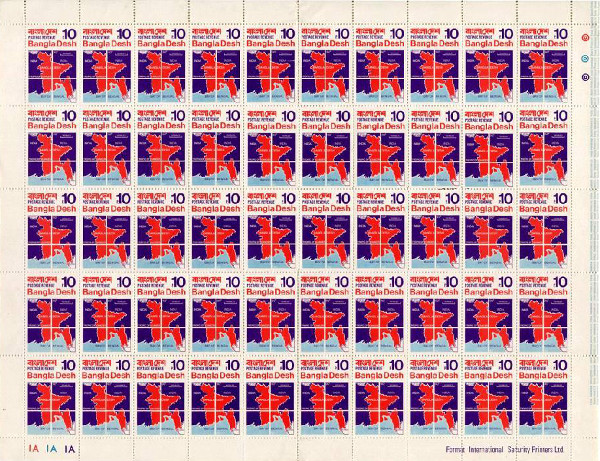
Note that the three lines of text are on the right side of the sheet near the CCMs, but positioned at the top.

On this sheet, the lines of text are on the left side near the plate number and positioned at the bottom

In this instance, the lines of text are on the left side at the top of the sheet

The first issue included plate numbers and CCMs (Color Control Marks). However, there has been no consistency in the use of plate numbers and CCMs in the following years. Some issues have neither a plate number nor a CCM. Over time, plate numbers were dropped altogether, and only the CCMs appear on the individual sheets of stamps

Note that the 20p value has the blue ‘Format International Security Printers, Ltd.’ text in small blue lettering running down the left margin of the block. In this instance, it does not extend to the bottom of the sheet. In some of the later ‘Bangladesh Liberated’ overprinted values, it does. The text apparently never runs continuously from the top to the bottom of the sheet but is instead shifted either toward the top or the bottom. It is also found on either the side with the plate numbers or the side with the CCMs.
It seems logical that all values would have been printed initially with Plate 1A, with subsequent printings using Plate 2A. Since Plate 1A exists on the 20 December overprinted stamps, it must also have existed in the first printing.

Genuine FDC of the first definitive issue, which was also the first stamps of the country. The stamps were officially placed on sale at the Dacca (later Dhaka) G.P.O. on 20 December 1971. Earlier FDCs had been produced and sold in London and India, dated 29 July 1971. On all genuine covers, the ‘E’ of ‘DEC’ is broken and appears like an ‘F’.

This image was sent to me by Michael Gallery, who met Mr. Biman Malik, the designer of the first set of Bangladesh stamps, in London in the spring of 2016. Mr. Malik later informed me during a telephone conversation that the cover is entirely fake, including the signature in the upper left corner, which was forged.
The information provided with this image states:
‘This FDC is an example of blatant plagiarism. The offence was committed by a high-ranking official of the Government of Bangladesh, who was also a barrister and therefore aware that plagiarism is a punishable crime. Under his instructions, through a respectable philatelist, this FDC was printed in Calcutta and sold to unsuspecting philatelists worldwide. Most likely, the respectable philatelist was unaware that he was handling stolen property.’


An early cover bearing three stamps from the first set, without the overprint. The cover was cancelled at Phultala on 25 April 1972 and arrived at Uttarpara on 28 April 1972.
20 Dec. – ‘Bangladesh Liberated’ overprint on #1, #7 & #10, measuring 12 mm horizontally
71-9 10p Map
71-10 Rs.5 Sheikh Mujibur Rahman
71-11 Rs.10 Support BanglaDesh
Total Stamps: 3
CCMs: Yes
Plate Numbers:
1A known for 10p, 20p, 1R, 3R, 5R, and 10R
1B known for 50p, 5R, and 10R
Perforation: 14½ × 14½
Sheet Size: 50
Designer: Biman Mallik
Quantity Overprinted: Unknown
Designer of Overprint: Format staff
Printer: International Security Printers Ltd., UK
Printer of Overprint: Unknown
FDC: Yes. Two different FDCs exist for this issue:
The genuine cover with a postmark reading ?
A second cover created months after 20 December 1971. In most, if not all, cases, all three stamps are on the same envelope. These were produced with the assistance of postal employees. They are collectible, difficult to locate, and expensive. They are easily identified as being on plain envelopes with the postmark reading “★ PHILATELIC BUREAU ★ DACCA G.P.O. / 20 DEC 71”. On these covers, the “E” of “DEC” is not broken, unlike on the genuine covers.
Postmarks: Philatelic Bureau
Insert: None
Additional Notes: See the Fake and Questionable Items page in the Table of Contents for more information on fake overprints.

Plate blocks of the 5R overprinted stamp. Note that there are two different plate numbers, 1A and 1B. It is believed that only a single plate was used for some values. Also, observe the positions of the three lines of small text in the margins.
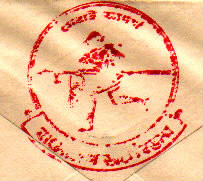
This logo was designed by Mr. M.A. Salam, to whom this catalog is dedicated. It was accepted by the Post Office and has been used on the majority of FDCs and Special Covers. The logo is a rubber-stamped image. Most later Postal Department–printed envelopes also include this logo.
The large red rubber-stamped image of a postal runner is the official logo of the Post Office and is printed on the back of all later First Day Covers and Special Covers. Since there was no time to produce official covers for the first stamps and the overprinted stamps, many privately produced covers were stamped with this logo on the back. These rubber-stamp logos are very scarce and not often seen.
The logo is generally printed in red, but it is also found in several other colors on covers produced later by the Post Office. Due to the high value of the one-rupee stamp, and the fact that the population had been at war for some time, dealers and collectors either could not afford or chose not to produce many covers using this value. As a result, many covers exist with only the two lower-value stamps on them.

A genuine First Day Cover of the 10p stamp with the ‘BANGLADESH/LIBERATED’ overprint in English and Bangla. Note that the date, 20 December 1971, is the same as for the first cover illustrated above. These stamps were all put on sale simultaneously at the Dacca G.P.O.
Right: A genuine First Day Cover of the 5R and 10R stamps with the ‘BANGLADESH/LIBERATED’ overprint. Although the complete set of stamps was overprinted, the government officially accepted only these three values. The other five values were never issued by the government.
The overprint exists in two different sizes: the genuine overprint measures 12 mm horizontally, while the other measures 13 mm. None of the 13 mm overprinted stamps are considered genuine and were never officially issued

This cover from the Jessore Post Office bears the three overprinted stamps with the correct date. However, it is an ‘after-the-fact’ cover, created sometime after the date on the envelope. It is considered a scarce cover.
The following stamps of the first set were overprinted with the same overprint as 71-9, 71-10, and 71-11, but were not accepted by the Post Office and were never officially issued:
71-1un 20p Massacre at Dacca University
71-2un 50p Nation of 75 Million People
71-3un R.1 Flag with silhouette of BanglaDesh in the centre
71-4un Rs.2 Ballot Box
71-5un Rs.3 Broken Chain – Proclamation of Independent Government
a. inverted overprint
Total Stamps: 5
CCMs: Yes
Plate #: 1A
Perforation: 14½ × 14½
Sheet Size: 50
Designer: Biman Mallik
Quantity Overprinted: Unknown
Designer of Overprint: Format staff
Printer of Overprint: Most likely Format International Security Printers Ltd.
FDC: Yes. Similar design to the 29 July 1971 envelope, but “Bangladesh” in Bengali on the left is red rather than green. The postmark is smaller and reads:
FIRST DAY / 20 DEC 1971 / DACCA / G.P.O. / PHILATELIC BUREAU
Postmarks: Dacca
Insert: None
Additional Information
The overprint exists on all eight values of the first set, but only the three values mentioned above were officially accepted by the Post Office.
At the time of their issuance in Dacca, only ten sheets of each accepted value were available, flown in by helicopter the previous day. Several years later, additional quantities of the stamps were discovered in the treasury.
The inverted overprint is believed to exist on all stamps of the set, but only the two mentioned have been documented.
Printer’s (Format Security Press) Drawings and Mockups:
One sheet with black-and-white drawings of all eight stamps and the overprint, indicating which parts are to be black and which red.
Rough “Bangladesh Liberated” in English and Bengali, showing the layout of the wording.
Refined printing in Bengali with “TOP” marking the correct position for the writing.
Cards with enlarged printing of “BANGLADESH LIBERATED” in English only, with long lines above and below.
Covers were later made with all eight overprinted values and cancelled on 30 December 1974 at Chittagong. These appear to have been created for philatelic purposes, as the entire set is on unaddressed envelopes.

Unofficial First Day Cover of the 12 mm overprint. This cover was issued by representatives of the Bangladesh government in England but was not officially sanctioned. It includes all values of the set, whereas the government officially accepted only three overprinted values: 10p, 5R, and 10R. Another overprint measuring 13 mm was also created, but it was not accepted by the government.
1971 – Unissued – “Bangladesh Liberated” Overprint (13 mm horizontally; found on all values of the first set, #1–8)
71-6un 10p Map
71-7un 20p Massacre at Dacca University
71-8un 50p Nation of 75 Million People
71-9un R.1 Flag with silhouette of BanglaDesh in centre
71-10un Rs.2 Ballot Box
71-11un Rs.3 Broken Chain – Proclamation of Independent Government
a. Unissued – four horizontal black bars across the face of Sheikh Mujibur Rahman. This stamp has only been found on a few covers to date, cancelled at Chittagong on 5 September 1975. The leader was killed on 15 August 1975. It is believed that the overprint and covers were prepared by an Indian dealer. The envelope is unaddressed.
71-12un Rs.5 Sheikh Mujibur Rahman
71-13un Rs.10 Support BanglaDesh
Total Stamps: 8
CCMs: Yes
Plate Numbers: 1A, 1B, 1C, 1D
Perforation: [Not specified]
Sheet Size: 50
Designer: Biman Mallik
Designer of Overprint: Format staff
Quantity Overprinted: Unknown
Printer: Format International Security Printers Ltd., UK
Printer of Overprint: Most likely Format
FDC: [Not specified]
Postmarks: [Not specified]
Insert: None


